First Ride: Manitou's New Dorado
The Manitou Dorado has been around for an astonishing two decades. So long that maybe a big proportion of riders out there have dreamed about owning one at some point in their riding life. I sure did, glued to the screen watching the freeride films of the early 2000s.
In that time, it has also gained quite a cult of keen admirers out there for its touted on-trail performance, something easily visible in the comments when any other dual crown fork is mentioned in an article.
For 2021, Manitou sought to continue that heritage, primarily by keeping the inverted design, but they were keen to point out that this is about where the similarities end, with the new fork in all three of its guises seeing a bewildering number of updates, changes and improvements across the chassis, springs and dampers.
The new Dorado is available in Pro, Expert and Comp models, with that Pro model seeing the return of a carbon fiber chassis.
Having just spent a bunch of time on a fair selection of the current crop of right side up DH forks, we jumped at the chance to get hold of the Pro and Expert models to dive into all the changes, and acronyms, for the new generation of Dorado as well as see how this icon of upside down compares on the trail.
While upside down forks might be much more popular in other two wheeled sports, they're not so prevalent in the MTB world. So perhaps the first point to attack is, why upside down?
According to Manitou, going with an inverted design allowed them to create a fork with a blend of increased fore-aft stiffness and increased torsional compliance. That's something they say allows the riders to have a better steering accuracy while reducing rider fatigue.
Diving deeper into that stiffness topic, torsional stiffness is something that inverted forks have always battled. Their fore-aft stiffness is much greater than a conventional design, but when things get twisted up the inverted design yields much lower stiffness figures when pitted against a conventional fork, with its additional bridge between the lowers tying everything together.
While many a brand has attempted to test an inverted design for DH, Manitou has stuck to their guns and sought to refine the Dorado boosting its stiffness, both fore-aft and torsionally, compared to the previous model.
Moving on from stiffness, the inverted design of the Dorado is said to keep the fork running with a smooth feel thanks to the more constant lubrication of the bushings and seals. The un-sprung mass compared to a conventional fork is also claimed to be lower, along with an increased sprung weight, which would translate to a fork more sensitive and able to track the terrain in front of it.
Manitou also states that the bushing overlap on an inverted design is greater than a conventional fork, thanks to the increase in space due to the long upper tubes compared to a conventional fork’s bushings in the lower legs.
The Dorado range is split into the Pro, Expert and Comp, with many shared features between the three. All Dorado models can fit both a 29" and 27.5" wheel into the same chassis with markings on the upper tubes acting as a guide for the minimum crown height for each wheel size.
They all also have the same crown options. The drop crown, more intended for the 29" wheels, has a 57mm offset. Whereas the flat crown, more intended for the 27.5" wheels, has a 47mm offset. It is possible to mix the crowns with the different wheel sizes, but to run the flat and shorter offset crown with 29" wheels means you have to have a total headtube and head set length shorter than 124mm, which many current DH bikes do have.
All forks use the same 37mm diameter lower leg, which is up 1mm from the previous Dorado and allowed Manitou to find their ideal balance of stiffness, weight savings and seal surface area to reduce friction, after testing many different diameters all the way up to 41mm. Those lower legs are protected with bolt-on plastic guards and there's also an optional one-piece fender kit that uses the same bolt-on design in place of the two lower leg guards.
Axle to crown measurements for the Dorado are 582mm in 27.5" setup and 602mm in 29". The brake mount is 203mm without adapters and can handle up to a 223mm rotor.
Recommended service intervals are every 50 hours for changing the bath oil and a re-grease of the air pistons and leg seals, then every 200 hours for a full service to replace all the fluids and seals. Extreme riding and harsh conditions may require you to service a little more frequently.
In the box along with the fork legs, crowns, lower leg guards and axle also comes a sag guide with integrated crown spreading tool. In the centre of the plastic injected tool includes the brake hose guide and two spacers and screws to fine tune the guide position. Also included is a stealth decal kit and boost hub spacer kit for anyone wanting to run a non-boost DH hub in the Dorado. The Dorado is available to buy through Manitou's distributor and dealer network as well as in their online store, which ships to the USA and Canada.
Dorado Pro
The top tier Dorado Pro sees the return of a carbon fiber composite chassis. The carbon fiber upper tubes save a claimed weight of 238g over the aluminum ones found on the Expert and Comp. Those legs are also completely carbon fiber, with only small aluminum sleeves top and bottom to thread the top caps and push the seals into the uppers.
The 6000 series aluminum lower legs use Manitou's Hex Lock axle system, which uses a hexagon shape to key the axle into the non-disc leg and resist the forces trying to spin the dropouts around the axle.
The 6000 series aluminum lower legs use Manitou's Hex Lock axle system, which uses a hexagon shape to key the axle into the non-disc leg and resist the forces trying to spin the dropouts around the axle.
Dorado Pro Details
• Dual chamber air spring
• IRT air spring adjuster
• Sealed TPC+ damper
• Hydraulic bottom out
• External LSC, HSC & LSR adjustments
• Carbon fibre upper tubes
• TSR relief buttons
• Adjustable between 180, 190 and 203mm
• 2970g (claimed)
• €1,499.99 / $1,799.99 USD
• Dual chamber air spring
• IRT air spring adjuster
• Sealed TPC+ damper
• Hydraulic bottom out
• External LSC, HSC & LSR adjustments
• Carbon fibre upper tubes
• TSR relief buttons
• Adjustable between 180, 190 and 203mm
• 2970g (claimed)
• €1,499.99 / $1,799.99 USD
The disc-side dropout also floats on the axle to find its perfect alignments, before being pinched down onto the axle. Compared to the previous Dorado, the new Pro is claimed to be 27% stiffer fore-aft and 22% stiffer torsionally.
The Pro model features the TSR, or Trail Side Relief, buttons to purge any excess built up air in the uppers, similar to what Fox has implemented on the 40, 38 and 36 forks.
The Pro uses Manitou's TPC+, or Twin Piston Cartridge, which is a fully sealed cartridge and builds on the damper design of the previous Dorado. TPC+ is a velocity and position dependent damping design. The velocity dependent part is the most common format of damping and gives the fork its high and low-speed damping, with high and low-speed compression and low speed rebound externally adjustable.
The position-sensitive damping part means that the fork is lighter on the damping when it is higher in its travel. As it gets deeper in there, the secondary TPC+ circuit engages and ups the damping force to give increased support and bottom out resistance. In the final 30mm of travel, an independent hydraulic bottom out circuit further increases the damping forces to deal with bottom out events on the trail.
Rebound is adjustable at the top of the fork, and opposed to other manufacturers, is blue. High and low-speed compression are at the bottom of the fork, with the low-speed dial coloured red. So don't go changing your red dial thinking that it's rebound.
The TPC+ damper uses a spring backed IFP, or Internal Floating Piston, that pressurises the oil in the cartridge, helping avoid cavitation while allowing room for expansion as the damper rod makes its way into the damper. Manitou say they used a coil backed IFP for more consistency on long DH runs when compared to a gas backed IFP.
The Dorado Pro air spring uses a twin chamber, positive and negative, design but with no dimple inside the fork leg to equalize pressure during the stroke. Instead, the balancing occurs when you inflate or deflate the fork with air with a small valve balancing the two chambers.
The IRT, or Infinite Rate Tune, adjuster adds further spring tuning options by having a secondary positive chamber that helps to control the middle and end of the fork's stroke, and is accessed under an air cap at the bottom of the fork. The IRT system is compatible with the Dorado Expert and is available as an aftermarket upgrade.
Any air sprung Dorado is adjustable in travel between 180mm, 190mm and 203mm, with all parts needed to do the travel adjustment being inside the fork and just need re-assembling in a different arrangement to make the travel changes.
The Dorado Pro retails for €1,499.99 or $1,799.99 USD and will be available in early Fall. Euro prices quoted are without VAT.
Dorado Expert
The Dorado Expert uses 6000 series aluminum lower and upper legs and is claimed to be 20% stiffer both fore-aft and torsionally compared to the previous Dorado.
The Expert has the TSR feature, but uses a small screw to allow the excess pressure to be purged instead of a button. The Dorado Expert is also e-bike approved.
A "half TPC+ damper" is found in the Expert model and uses a non-sealed cartridge design. This updated version of the damper sees redesigned architecture to reduce pressure losses during the rebound stroke by separating the check valve from the compression pistons.
The Expert has the TSR feature, but uses a small screw to allow the excess pressure to be purged instead of a button. The Dorado Expert is also e-bike approved.
A "half TPC+ damper" is found in the Expert model and uses a non-sealed cartridge design. This updated version of the damper sees redesigned architecture to reduce pressure losses during the rebound stroke by separating the check valve from the compression pistons.
Dorado Expert Details
• Dual chamber air spring
• IVA volume adjuster
• TPC+ damper
• Hydraulic bottom out
• External LSC, HSC & LSR adjustments
• 6000 series aluminum upper tubes
• TSR bolts
• Adjustable between 180, 190 and 203mm travel
• 3120g (claimed)
• €1,193.28 / $1,449.99 USD
• Dual chamber air spring
• IVA volume adjuster
• TPC+ damper
• Hydraulic bottom out
• External LSC, HSC & LSR adjustments
• 6000 series aluminum upper tubes
• TSR bolts
• Adjustable between 180, 190 and 203mm travel
• 3120g (claimed)
• €1,193.28 / $1,449.99 USD
A single, high-flow check valve is used to increase the oil flow for a claimed improvement in small bump absorption and increased damping consistency. The hydraulic bottom out circuit now resides inside the damping cartridge to be fully submerged in the damping fluid to further improve consistency.
All the adjuster and detent designs have changed to give a better fine tuning of the adjustment range, and like the Pro, the rebound is adjustable at the top of the fork with high and low-speed compression adjustable at the bottom.
The Dorado Expert uses a dual air chamber spring design with the same balancing valve that equalizes the pressure in the chambers when you fill the fork. But in the Expert, there is an IVA, or Incremental Volume Adjuster, tuning option that gives three settings for air volume inside the fork to change the progressivity, much like tokens do in other forks.
The Dorado Expert retails for €1,193.28 or $1,449.99 USD and is available right now. Euro prices quoted are without VAT.
Dorado Comp
Last but not least is the Dorado Comp, which uses the same 6000 series aluminum chassis as the Expert model giving it the same stiffness gains compared to the previous Dorado. It also uses the same TSR screws and is e-bike approved.
The Comp uses a coil spring design with six different steel spring rates from 25lb/in up to 50lb/in in 5lb/in increments with coil spring preload adjustable externally. Travel for the Comp is fixed at 203mm.
The coil spring system can be fitted to the Pro and Expert models in place of their air spring.
The Comp uses a coil spring design with six different steel spring rates from 25lb/in up to 50lb/in in 5lb/in increments with coil spring preload adjustable externally. Travel for the Comp is fixed at 203mm.
The coil spring system can be fitted to the Pro and Expert models in place of their air spring.
Dorado Comp Details
• Coil spring
• IRT volume adjuster
• ABS+ damper
• Hydraulic bottom out
• External LSC & LSR adjustments
• 6000 series aluminum upper legs
• TSR bolts
• Fixed 203mm travel
• 3565g (claimed, medium spring)
• €1,008.40 / $1,224.99 USD
• Coil spring
• IRT volume adjuster
• ABS+ damper
• Hydraulic bottom out
• External LSC & LSR adjustments
• 6000 series aluminum upper legs
• TSR bolts
• Fixed 203mm travel
• 3565g (claimed, medium spring)
• €1,008.40 / $1,224.99 USD
But once that conversion is done it’s irreversible due to the potential for the coil spring to mark the inside of the tubes and lead to sealing issues if you change back to an air spring.
The Comp uses Manitou’s ABS+ damper, which has been with Manitou for almost as long as the Dorado itself, although with many refinements over the years. The damper has reliable and easy tuning and features externally adjustable low-speed compression and rebound.
The Dorado Comp retails for €1,008.40 or $1,224.99 USD and is available right now. Euro prices quoted are without VAT.
Installation, Setup & Ride Impressions
Having only ever touched conventional forks, this was the first time handling an inverted design, something that literally hit me by surprise when I pulled the fork out of the box without the crowns and got smashed in the shins by one of the legs as it swung round on the axle. Some mistakes in life you have to experience once to make sure you'll never make them again.
That non-conventional theme has carried on through a little with getting used to the day-to-day use of the Dorado and its inverted design. Crown assembly in the bike is a regular affair however, although I had to add 5mm of spacers under the top drop crown to avoid it hitting the frame of the Trek Session, even with the bumpers in a good position.
The markings on the upper legs make it easy to get the right leg position for the different wheel sizes, and for the testing so far I've been using 29" wheels. It's good to point out, though, to align the small rubber bumpers with the fork guards to quieten any rattling.
Wheel assembly can be a bit fiddlier on the Dorado than a conventional fork, with the two dropouts able to move relative to each other. But it's not a headache, unless you have a front hub that needs a finger sticking in it to align the tube spacer between the hub bearings. The axle design uses a covered end that houses the bolt to preload the axle, so a lot of wiggling and jiggling is needed with those hubs. A normal hub, with a tube spacer that stays in place, is much easier to assemble.
All crown and axle bolts use a 5mm Allen key, meaning it's super easy to whip through the whole fork and tighten everything up. And the whole fork only really comes together and rigid once all the bolts are done up tight. Those torque values needed to be a bit higher than the crown and axle bolts on a lot of the conventional forks out there.
Since I run my front brake on the right side, I needed to change to a longer hose to account for the Dorado's longer hose path up the legs and through the hose guide. Once that was done I was good to go and the adjustable angle and height of the hose guide makes it possible to get the routing just right and allow the hose to slide freely though as the fork goes into its travel.
Our Dorado Pro came in at 3,003g with the long offset drop crowns, uncut steerer, axle and fork bumpers. The Expert came in at 3,213g for the same setup. That puts both forks a fair bit heavier than the Öhlins DH38 m.1 (2,822g), Fox 40 (2,770g) and RockShox Boxxer (2,588g) we tested earlier this year.
The Dorado setup guides are incredibly informative and comprehensive. There are multiple setup range suggestions for standard, DH race and park riding preferences, along with clear explanations of what each adjustment does and recommendations for what to adjust for specific riding situations, problems or preferences. And using them as the starting point has had the forks in a very good place straight out of the box. I started the Dorado Expert at 69psi, IVA setting 2, 11 clicks of rebound, 6 of low-speed compression and 9 of high-speed compression. I started the Pro at 60psi in the main chamber and 91psi in the IRT chamber, 11 clicks of rebound, 6 of low-speed compression and 9 of high-speed compression.
The Dorado Expert was the first to arrive, and as such, I've had just over 13 days total on it so far. While its weight is noticeable, especially when lifting the front end, those initial settings from Manitou have made the fork really easy to just get on and ride hard. It's soft and supple when you need it to be, hard and supportive when you need that, while maintaining a good ride height and usage of travel. Put simply, the way the fork goes in and out of its travel is proving to be quite impressive so far in all terrains and speeds that I've ridden. I haven't yet felt the need to fix any problems in the way the fork rides with air pressure, progressivity or big changes in damping.
Our little area of the Alps has been having one of the wettest summers in recent memory, and as such it has rendered the pucker factor pretty high on a lot of the trails in Châtel, Morgins and Champéry, where the forks have been ridden so far. Perhaps owing to this it's been hard to decisively pass judgement on the Dorado's stiffness traits as yet, compared to a conventional design.
But perhaps its comfortable right out of the box performance might be owing to just this in these wet and slippery conditions. In root or rock infested trails there certainly isn't a sense of the front wheel pinging around off line, and it's easy to hold lines and cambers with the Dorado up front. It's also given no sense of loading up and suddenly springing back so far, not even in the tightest and most aggressive turns. But in just those turns, where you are really grabbing the bull by the horns, there is a sense of a touch more hand movement at the bars. It doesn't translate to vagueness, but there's a different feeling to the Dorado compared to a conventional fork design.
One of the biggest shows of the Dorado's torsional flex is when you grab the front wheel between your legs and twist the bars. There is an alarming amount of movement in there and to the point that it will leave the front wheel and bars pointing in different directions. While it might be a good party trick when not riding, it's going to be one of the biggest points to test with the Dorado and its conventional design competitors, who yield a much more rigid feeling under the same basic test. Something that many back-to-back runs, switching forks repeatedly is going to give a clearer picture of if this torsional flex is a positive or negative, or both, depending on the trail and conditions.
The Dorado Pro arrived more recently, and after a solid two days of giving it hell in the bike parks of Châtel and Morgins, its performance has been mirroring that of the Expert, in the way it goes in and out of its travel over everything from the big jump trails, through the steep and technical to fast and demanding being impressive. Again, it was a cinch to set up with Manitou's guide and so far is exhibiting the same suppleness that builds into nice support deeper in the travel. All combined with good control and usage of travel that allows you to just forget a little bit more about your bike, lift your eye line and focus on the trail. Its reduced weight, some 210g, is also noticeable. It's not front and centre but it's a chunk of weight less to pull up every time you need to.
We'll be putting the Dorado Pro and Expert through their paces in the coming weeks to not only compare them to one another with all their individual features, but I'm also really looking forward to putting the Dorado's inverted design back-to-back against the likes of its conventional competitors, the Öhlins DH38, Fox 40 and RockShox Boxxer, to come back with a more conclusive answer to the inverted versus conventional design question. All I need now is a fork stiffness test machine...
For more information on the Dorado head to manitou.com.
Author Info:
Must Read This Week
Sign Up for the Pinkbike Newsletter - All the Biggest, Most Interesting Stories in your Inbox
PB Newsletter Signup
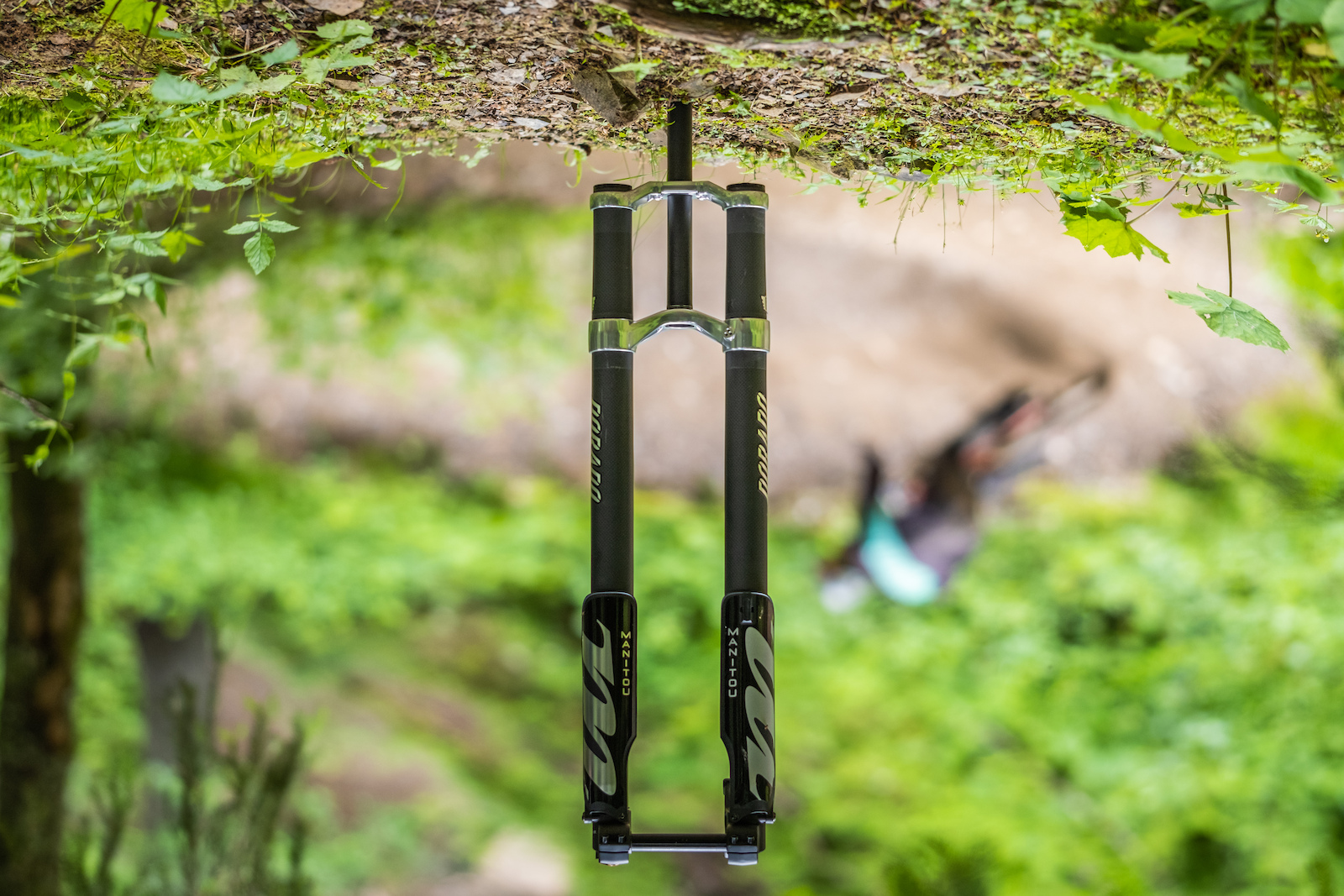


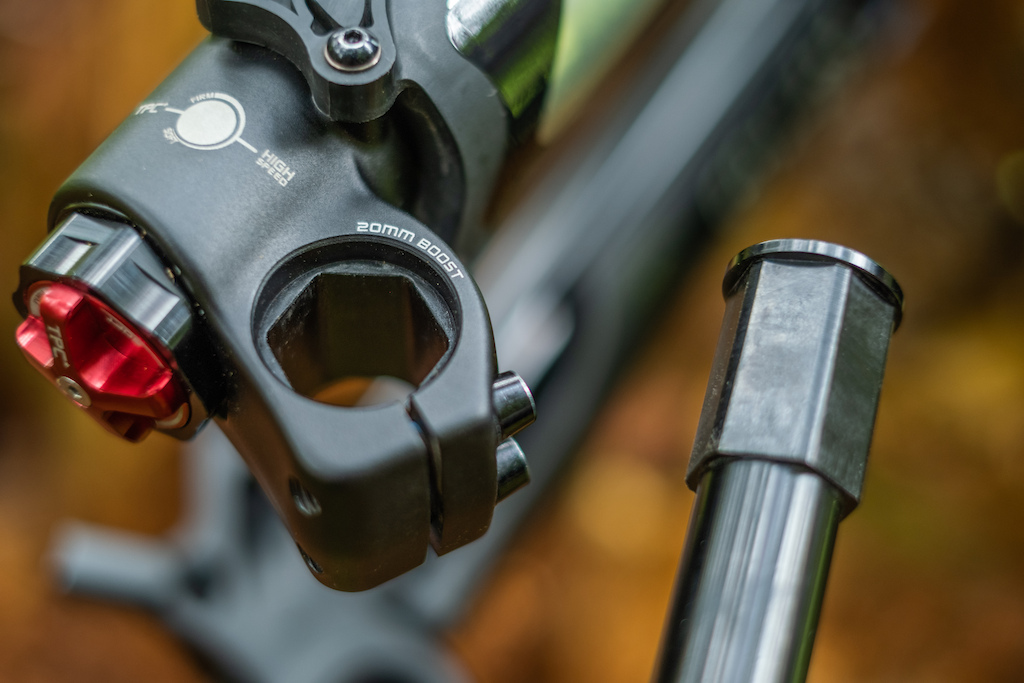

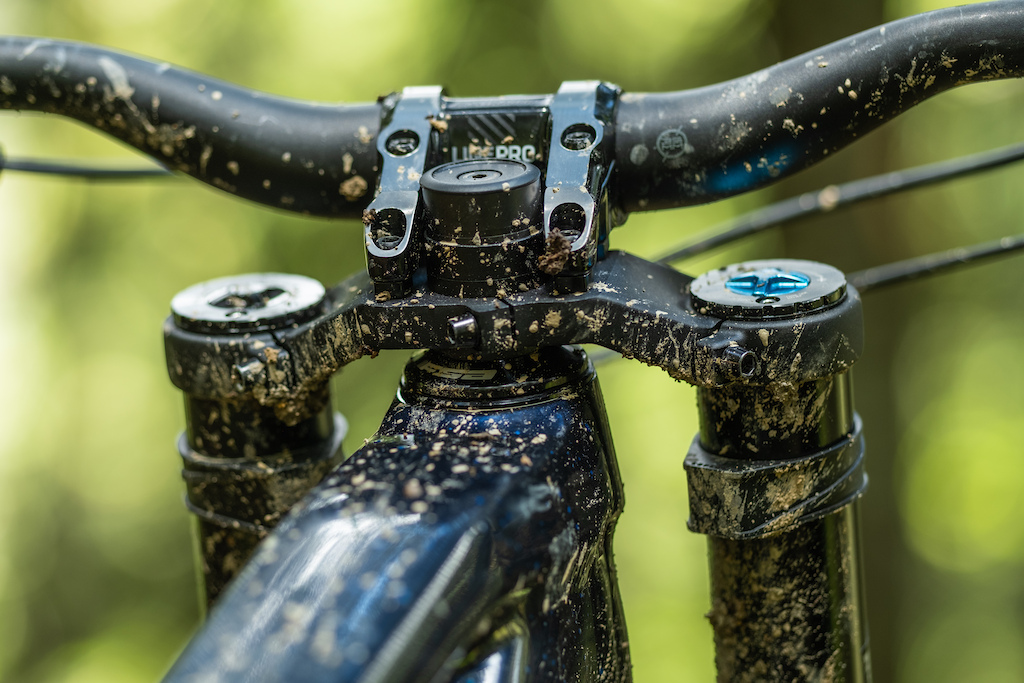

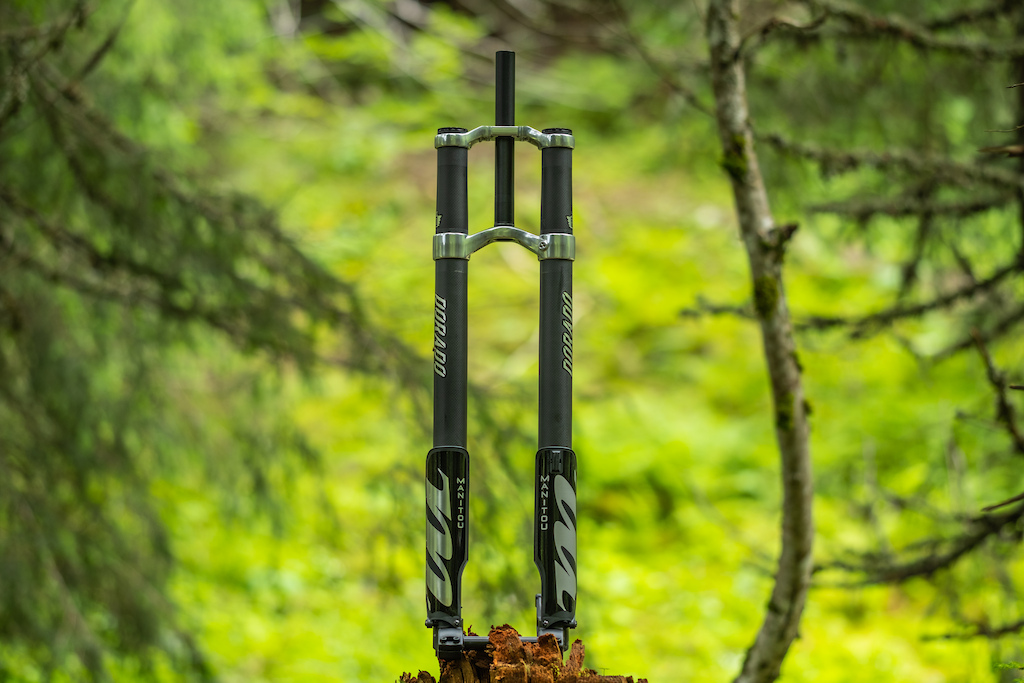




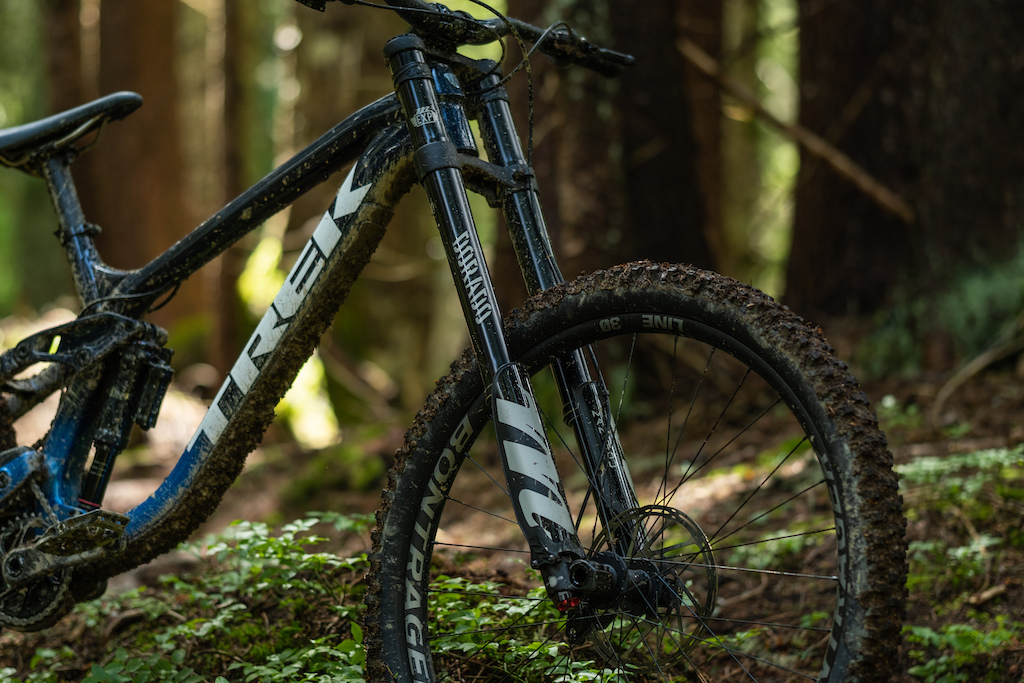


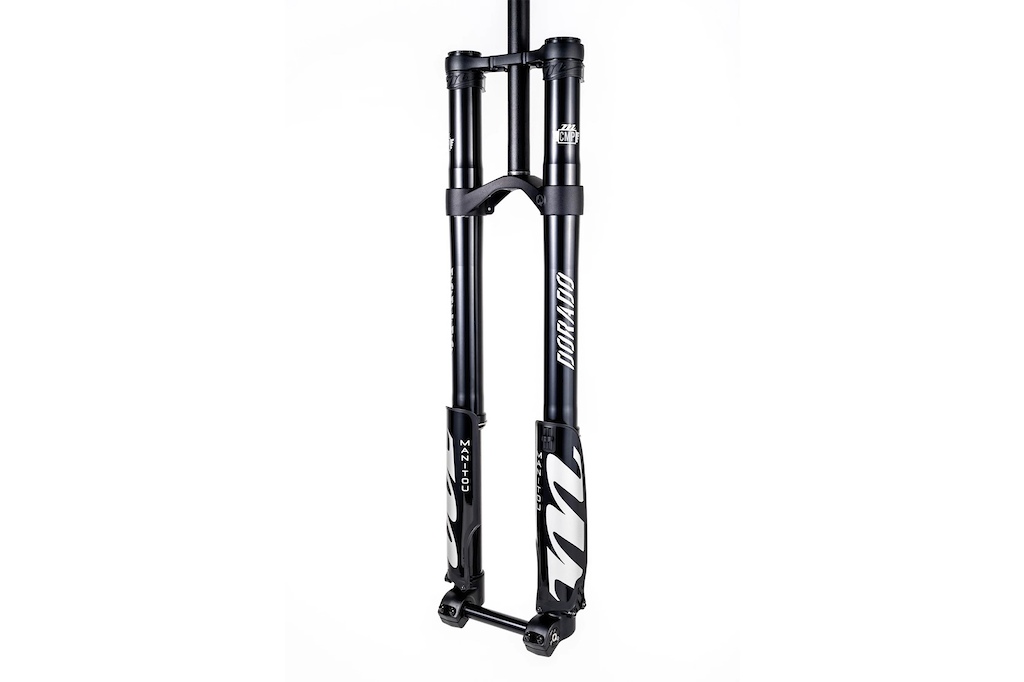
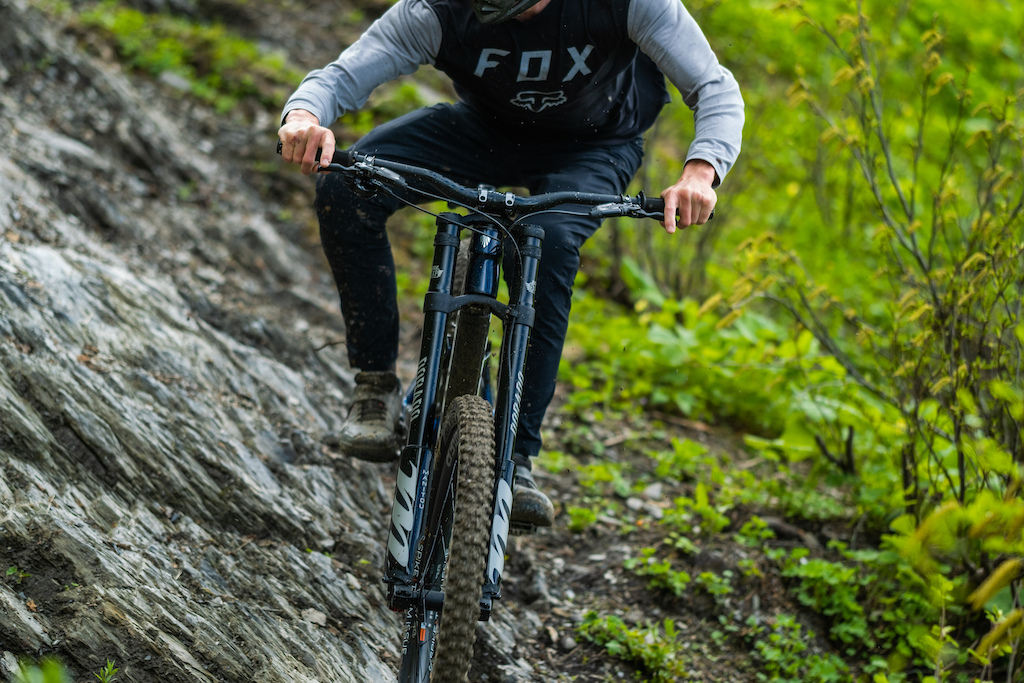





The fork is always in the back of my head
The small amount of give makes it track off camber better. It's a feature, not a defect!
The lefty should have superior stiffness to normal forks and smoothness due to the pin bearings and it being USD however whenever it has been on a bike they review it barely gets a mention.
My conclusion is that the damper and spring together must be worse then other brands because of the compromises they made to make it fit in the chassis.
If the damper plus spring was better, then I'd think they'd be proclaiming it the best fork ever ridden when reviewing it.
That's what I suspect though as I have no proof.
That said. If Manitou make another single crown Dorado I'll buy one for my collection.
Way too many misinformed people have an all or nothing view of these forks. They are either the absolute best possible thing and why would you run anything else, or they are the wettest noodle of a fork around and you'd be silly to buy one. What about if they are simply just GOOD?
Sid SL is a different story. I never claimed that was stiff.
Since the lefty uses a square upper stanchion (triangle now in the single crown version) its limited in how much travel it can have, and frankly I'm impressed they got 160mm out of it.
The struggle with the Lefty wasn't the design. The chassis is brilliant, and I think its the best of any front suspension ever. The issue is in their manufacturing process/QC and the design of their damper. The damper was crap and couldn't compete. The shock itself was still really good if you got a good one, but there were so many lemons. Most people didnt' get a "good" one. The tolerances are probably pretty tough, and C'Dale just couldn't get them consistent.
I am thinking about experimenting- buying a 650b lefty, cutting off the crowns and machining my own to allow 160mm 29er, and putting a Boxxer damper in there with a coil-over (probably from a Boxxer too)
I just finished my custom designed ti bike (but made for 170mm 29er; I wonder if I can eek out another 10mm out of that 650b 160mm lefty ) but I'm working on a steel framed ebike next. Maybe after that I'll have some time for a franken-lefty
www.pinkbike.com/photo/20805694
Shame it was let down by poor damping, as others have said. Doesn't count for much if it tracks well but then beats hell our of you the moment things get rough.
I've got one of the X-Fusion Revel inverted forks, and they have keyways in them to resist that torsional twist and add stiffness. It's got bushing problems and could do with a better spring, but otherwise it's a good fork. If a company were to be successful with a single-crown inverted fork, bearings like the Lefty or keyways like the Revel would probably be the way to reap the benefits of an inverted chassis without sacrificing too much stiffness.
This seems like a big deal for anyone wanting the option to upsize/downsize/mulletify in future. The resale value should hold up better than a 27.5 boxxer/40 too.
Lol
Got it on my gravel/old scool geo rig, can't say enough good things bout it.
Top to bottom, manitou is the best overall...their high end mattoc / mezzer is as good or better than the competition BUT what really sets them apart is the overall (high end AND low end)....you can get a low end manitou that is excellent. So, what's nice is that if your fork says manitou, you can bet its good.
Most companies performance drops off substantially on low end / cost stuff...
Unlike all the other companies, they follow the path of cheaper-simpler. And for a rider like me, I actually perfer this approach. Don't need every setting/adjustment under the sun.
In my eyes, that's what sets them, and Suntour, apart; User serviceability.
If you've had your R7 Pro for a while, are there any tuning improvements/mods you'd recommend to get the most out of it? I've read a bit about bumping up the negative volume and reshimming the damper. I'll run it for a bit before changing anything, but do you think those mods are really needed to take it from good to great?
Everyone in the Western US is trying not to cry right now
― Frank Herbert, Dune
You love dust? I have a mountain of it for you here!
When I rode Lithium just a few days before, it was moondust with craters everywhere, so I hope its better now (was with the wife and kids, so minimal riding)
It's worth keeping in mind that all 155lb of Kaz definitely noticed a lack of stiffness from the last USD fork he reviewed (Intend). I don't think it's crazy to investigate certain attributes more based on the design.
And for the record, I love USD forks.
I also think it would be interesting to have riders of varying abilities in the test, like a relative amateur, someone who is midpack senior at national enduro races, as well as someone at expert/elite. I can imagine the amateur rider preferring the bigger more stable bike on a track they find challenging, compared to an elite for whom the track is not difficult, they are just trying to find milliseconds.
When MX bikes went to upside down forks many years ago, they were so stiff people didn’t want to ride them. Some pros were installing right side up forks for racing!
The Honda XR650, a big, off road race/play bike stuck with right side up forks (and a steel frame) for years just to be more compliant.
I don’t think you can find a race bike without USD forks anymore. Road, MX, trail, it’s a given. Efforts have been made to give them more flex for some applications.
???
USD forks and aluminum frames changed the face of motorcycles. Turned a lot of play riders off in the process.
One claim I remember from the transition period is that the big fork tube is much stiffer than the stanchions. Hence having them in the triple clamp instead of the stancion was inherently stiffer. And yes, the tube overlap was always more with USD.
In fact, I think Showa or Kayaba went to small diameter forks for the Japanese MX bikes because they were just too stiff. Like Yamaha’s original aluminum MX bike frames.
Maybe the leg stance was wider, I don’t remember.. But yes the axle clamp was as much an issue in Moto as it is in Mtb. And these forks use the same system as Moto!
*(not saying moto riders are bigger/fatter, but that they generally wear more and heavier protective gear)
You guys make forks for everything from Mtb’s to MotoGP machines!
Damage to the lower stanchions has been a factor ever since MX went inverted. I ran without “roost guards” on my old MX bike once.My own roost off the front tire did real damage to the tubes!
Don’t know if this has been touched on, but unsprung weight was said to be lighter going inverted. Stanchions lighter than sliders- makes sense.
I think the unsprung weight issue was also addressed with the advent of cartridge rod forks in the 1980’s. I believe it moved the rebound adjustment into the fork cap, which freed it up from the bottom cap. Then came the twin chamber forks, where the damping was in a separate chamber from the fork bushing oil.
My 2006 Yamaha YZ250F didn’t have a separate damper chamber. Now all Mtn bike forks do!
The bridge is an interesting point.. Wonder is the torsional stiffness question is now answered..?
Forgot about the improved ground clearance from inverted forks on dirt bikes. That really helped in some awful off road riding. As did wrap around lower fork protectors.
@ExMxEr: I'd love to see some hard numbers for unsprung weight too. Probably tough to test though... Coast down a rough piece of trail a few times with one accelerometer on the axle and one on the front triangle, pull off the mech and cassette, repeat, see what changes? I have a hard time believing it would be significant.
On the subject of damage to upside down forks, I have never, despite being one of the most technically incompetent riders ever to contest my local (moto) enduro series, managed to damage a lower fork tube. I have damaged one of the seals, though, resulting in all the oil draining out of one leg. If the silly little plastic guards had extended an inch higher, it probably wouldn't have happened.
I sent them to Pro Circuit for a revalve and they used some light grinder on the tubes to knock down displaced material, and told me good luck..
They didn’t leak, and didn’t seem to destroy the seals. I got lucky..
I lived in the Rocky Mountains most of my life, and got stopped dead on a tight trail by jamming my lower fork leg into a boulder once. That left a mark…
Lowers are in the 700g range, each tube of an inverted fork, without the dropouts, would be around 350g each. So "lower unsprung weight" is a nonsense.
This is not a bug, it’s a feature.
www.youtube.com/watch?v=nLO4D-mMpdk&t=163s
If unsprung weight really was an issue, you wouldn't see the MTB community salivating at the thought of sticking 250g inserts into their 1500g tyres.
I guess that’s the “Ex” part of my handle.
Thanks man!
On a motorcycle the riders weight varies the same (or even more) but the motorcycle itself is heavier than the mtb (at least till so far)
; )
Hopefully this will be available for the new fork as well.
Might be a piece of velcro would work too.
COIL is available! Buy the top fork to get the damper, buy the coils. Or buy the Comp and upgrade the damper from the Pro and you have a COIL fork.
As for E applications they consider the bike weight, speed, motor power and estimated rider weight.
Raise your hand if you think a DH fork gives a damn about a 10kg heavier frame and faster uphill times?
I'd sacrifice a little torsional stiffness for increased fore/aft stiffness and increased lateral stiffness any day.
But that's always going to ne a problem for companies trying to market these things. Even if they offer superior performance for all but high level riders, if they can't put it under a top pro, many will always see it as an inferior product.
I'm raffling off my custom Manitou Dorado RRT, you can win it for only £3!
raffall.com/244971/enter-raffle-to-win-manitou-dorado-rrt-fork-hosted-by-paul-aston
I ran a first year Dorado 275 for a number of years on two frames. I have no real complaints about the fork. I still have it, since I still might install it on a DH bike.
I had a Moto 120 back in the day, which was their first USD fork. Around that time, Foes, Manitou, Mountain Cycle, and White Brothers we’re making USD forks as well but all had round stanchions.
One trip to the hardware store and all this jabbering about flex would go away. It would be replaced with different jabbering about flex.
I used to have an old carbon Dorado way back in the day, hopefully I can ride one of these new ones one day as well
Yes I've been riding them.
One big upside to USD forks is that the unsprung mass is less that ond a RSU fork, meaning it should feel much smoother and softer
not that i'm opposed to usd forks in general. i had a couple whitebros back when i was racing dh, that worked quite well. just don't think we'll ever see mainstream acceptance. though that's what i used to think about high pivot bikes (as an ex brooklyn owner) and look as us now!
that said, we are fast approaching the time when MTB manufacturers are going to, nay, need to, start considering lateral compliance in frames and forks. Just like road race motos. suspension becomes less effective the further from it's vertical axis you lean it. while lean angles of MotoGP @70º aren't really a worry in MTB, there is something to be said for a bikes handling at 20º of lean through a rock garden versus 0º.
TLDR: there IS such thing as too stiff of a bike